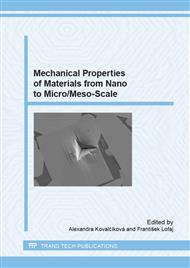p.107
p.111
p.115
p.119
p.123
p.129
p.134
p.138
p.142
Influence of Hot Corrosion on Local Mechanical Properties of HVOF Sprayed Coating Based on NiCrBSi Alloy
Abstract:
Ongoing increase in demands on efficiency of power plants and other facilities leads to increased interest of new progressive materials and technologies. One of the modern methods which lead to enhancement of surface properties is application of coatings on surface of components composed of less quality materials. Commonly used methods protecting components are based on some form of heat treatment. The current pressure on increasing operating temperatures for enhanced performance of steam turbines caused elevation of operating temperature at limit of the applicability of commonly used protections. From this reasons the demand for using an alternative technologies which would provide such a desired protection rises rapidly. One of the key areas of protection in such environment is protection against hot temperature corrosion. Possible solution can be found in application of coatings based on alloys and cermets prepared by HVOF technology. This paper examines local mechanical and microstructural properties of NiCrBSi coating after exposition to extremely severe hot corrosion environment. Furthermore, the nanoindentation measurements of NiCrBSi coating were performed before and after the corrosion test. In this case the mixture of salts composed from 59% Na2(SO)4 with 34.5% KCl and 6.5% NaCl was used. Temperature of test was set on 525°C and 575°C. Duration of exposition to hot corrosion environment was 168 hours in autoclave.
Info:
Periodical:
Pages:
123-126
Citation:
Online since:
September 2015
Authors:
Keywords:
Price:
Сopyright:
© 2015 Trans Tech Publications Ltd. All Rights Reserved
Share:
Citation:


